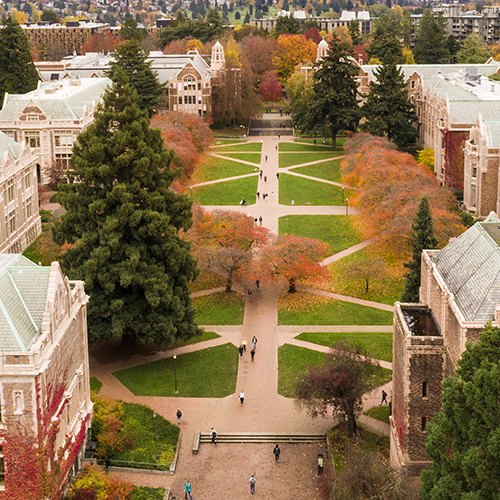When UW students are curious about philosophy, they often start with a 100- or 200- level course to test the waters. Not Sam Hopkins (BS, Mathematics, Computer Science, 2013). Hopkins, recently named 2013 A&S Dean’s Medalist in the Natural Sciences, dove right into a 400-level epistemology course. “I’m not easily intimidated,” he says.
Hopkins, who entered the UW at age 15 through the Early Entrance Program, loved the course. He took more philosophy courses, envisioning a major in philosophy. But an epiphany during his second year led him in another direction. “I realized I missed math,” says Hopkins. “I missed it quite a bit.” An honors course in advanced accelerated calculus, taught by Professor James Morrow, sealed the deal. “He gets people hooked,” Hopkins says of Morrow, Sando-Rebassoo Professor of Mathematics.
Hopkins also took computer science courses. Through an NSF Research Experiences for Undergraduates (REU) summer program at Rutgers University, working with computer science professor Eric Allender, he focused on complexity theory, an area of computer science research that dovetails with mathematics and philosophy, bringing together all his interests.

“In philosophy, my focus has been the philosophy of mathematics and logic,” explains Hopkins, who earned a minor in philosophy. “My computer science research is very mathematical, raising questions that are philosophically motivated. I do feel that I work at the intersection of all these fields. I find theory of computation and logic extremely beautiful.”
Hopkins explains that, unlike computer scientists who stare at computer screens all day, much of his mathematics-based research in computer science takes place in his head and on a chalkboard. “Mathematical research is an odd thing,” he says. “There are no petri dishes moving around, no detailed logs of experiments. You start by reading papers in areas that interest you, then pray that they lead to an idea to work on. When I was at Rutgers, I would hole up with a chalkboard for a day, writing what I knew and trying to inch a little further.”
Upon his return from Rutgers, Hopkins continued in the same research vein with UW computer science professor Paul Beame, working with him for two years. “I spent the first year reading papers,” says Hopkins. “It takes a lot of time getting to the front, finding a problem that you want to work on. A lot of research goes into framing the problem correctly, so you’ll be able to find a solution. The biggest role of a mentor in math is helping with that.”
Curious about his next step after graduating, Hopkins spent last summer interning at Google to see what an industry job would be like. He worked on a programming language design team alongside PhDs, which was a perfect fit. “Sam immediately grasped very subtle concepts,” recalls Vijay Menon, a Google staff software engineer who supervised Hopkins. “Since he left, the team has…[been] building upon his initial design and implementation.”
Menon was equally impressed with Hopkins’ communication skills. “Sam could articulate his work and the overall effort better than most full-time Google engineers,” comments Menon. “We were confident enough in Sam to ask him to present intermediate work internally, to one of our vice presidents, and externally, to the broader engineering community in a webcast. His end-of-project write-up was also exceptional. He evaluated different options, made recommendations, and found hard data (even when we did not ask for it) to back up his conclusions. We have gone back to his write-up several times since he left to guide our further decisions.”

That Hopkins held his own working collaboratively with PhD computer scientists is no surprise to his UW professors. After all, he’s been taking graduate courses for several years, thriving despite the challenging material. Yet Hopkins also enjoys working with younger—much younger—mathematicians as a Math Circle volunteer. UW Math Circle is a Department of Mathematics program through which UW students meet weekly with elementary and middle school students to explore math problems they would not encounter in their K-8 classrooms.
“I do math for aesthetic reasons, and I want to share that with people,” says Hopkins. “A lot of K-12 math makes it such a grinding bore. I want to open people’s minds to see that math is beautiful—complex and interesting and challenging. I’d love to create an environment for elementary school students to see the same wonderment and discovery that I feel when doing a research project.”
Hopkins also served as a teaching assistant for a UW computer science course and worked as a tutor in the Philosophy Writing Center for two years. “The Socratic approach is a big part of philosophy,” says Hopkins. “That means that, as a tutor, you have to be on your toes. You have to be as engaged with the material as the student is. When you can be, it’s really fun.” This fall, Hopkins heads for Cornell University as a graduate student in computer science. Asked whether he will
choose a career in academia or industry, he just smiles. “Two years ago, if you asked me to predict what I’d be doing now, I’d give all the wrong answers,” he says. “It’s the same thing now. If I were to predict where I’ll be in five years, I’d probably be wrong again.”
More Stories

A Healing Heart Returns
In February, the UW Symphony will perform a symphony that Coast Salish elder Vi Hilbert commissioned years ago to heal the world after the heartbreak of 9/11. The symphony was first performed by the Seattle Symphony in 2006.

The Public Impact of Private Cities
Geography major Edwin Bai has researched private cities, developed by individuals and corporations, that "take the libertarian idea of low government regulation to the maximum."

Awards for Research, Social Justice Efforts & More
Recent awards celebrate Arts & Sciences faculty, staff, and alumni for their research, social justice work, lifetime achievements, and more.